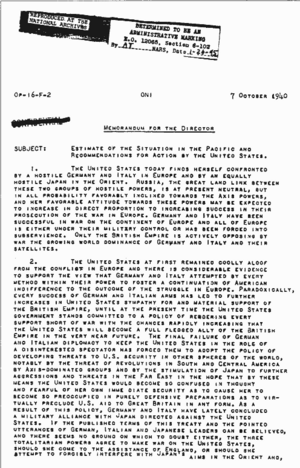McCollum memo facts for kids
The McCollum memo, also known as the Eight Action Memo, was a memorandum, dated October 7, 1940 (more than a year before the Pearl Harbor attack), sent by Lieutenant Commander Arthur H. McCollum, who "provided the president with intelligence reports on [Japan]... [and oversaw] every intercepted and decoded Japanese military (though the military code had not been broken) and diplomatic report destined for the White House" in his capacity as director of the Office of Naval Intelligence's Far East Asia section. It was sent to Navy Captains Dudley Knox, who agreed with the actions described within the memo, and Walter Stratton Anderson.
The memo outlined the general situation of several nations in World War II and recommended an eight-part course of action for the United States to take in regard to the Japanese Empire in the South Pacific, suggesting the United States provoke Japan into committing an "overt act of war". The memo illustrates several people in the Office of Naval Intelligence promoted the idea of goading Japan into war: "It is not believed that in the present state of political opinion the United States government is capable of declaring war against Japan without more ado [...] If by [the elucidated eight-point plan] Japan could be led to commit an overt act of war, so much the better."
The McCollum memo was first widely disseminated with the publication of Robert Stinnett's book Day of Deceit: The Truth About FDR and Pearl Harbor. Stinnett writes that McCollum's memo was a plan to "mobilize a reluctant America into joining Britain's struggle against the German armed forces then overrunning Europe. Its eight actions called for virtually inciting a Japanese attack on American ground, air, and naval forces in Hawaii, as well as on British and Dutch colonial outposts in the Pacific region." Stinnett presents the memo as part of his argument that the Roosevelt Administration conspired to secretly provoke the Japanese to attack the United States in order to bring the United States into the European war without generating public contempt over broken political promises. Stinnett attributes to McCollum a position McCollum expressly repudiated.
The Eight-Action plan
The McCollum memo contained an eight-part plan to counter rising Japanese power over East Asia, introduced with this short, explicit paragraph:
- It is not believed that in the present state of political opinion the United States government is capable of declaring war against Japan without more ado; and it is barely possible that vigorous action on our part might lead the Japanese to modify their attitude. Therefore the following course of action is suggested:
- A. Make an arrangement with Britain for the use of British bases in the Pacific, particularly Singapore
- B. Make an arrangement with the Netherlands for the use of base facilities and acquisition of supplies in the Dutch East Indies
- C. Give all possible aid to the Chinese government of Chiang-Kai-Shek
- D. Send a division of long range heavy cruisers to the Orient, Philippines, or Singapore
- E. Send two divisions of submarines to the Orient
- F. Keep the main strength of the U.S. fleet now in the Pacific[,] in the vicinity of the Hawaiian Islands
- G. Insist that the Dutch refuse to grant Japanese demands for undue economic concessions, particularly oil
- H. Completely embargo all U.S. trade with Japan, in collaboration with a similar embargo imposed by the British Empire
- If by these means Japan could be led to commit an overt act of war, so much the better. At all events we must be fully prepared to accept the threat of war.


